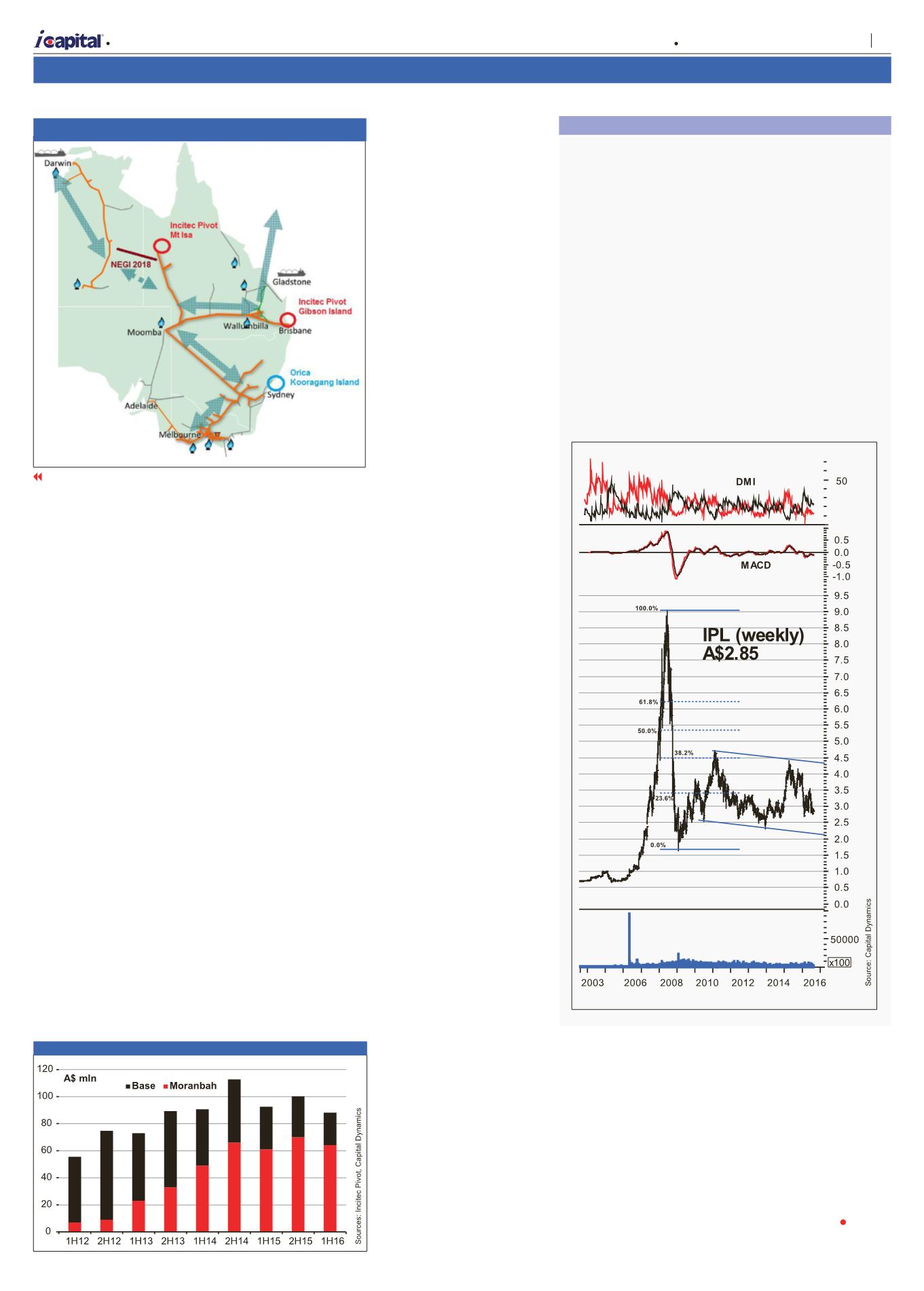

The week of 18 August – 24 August 2016
Volume 28 Number 01
FROM PAGE 24
Technical Analysis
Of Incitec Pivot Limited
Listed on the ASX in Jul
2003, Incitec Pivot Limited
(IPL) traded sideways for
3 years. Then, with the
acquisition of Southern
Cross Fertilisers (SCF) in
2006, it rocketed to a high
of A$9.00, an impressive
800% growth as a result
of the continuing success
of their cost savings
programme, the integration
of SCF and the subsequent
acquisition of Dyno Nobel.
Unfortunately, the 2008
US-led global financial crisis
sent it plunging in a vertical
manner to retrace almost its
entire surge. The recovery
was slow for IPL and
hovered around the lower
boundary for 2.5 years.
Its weekly MACD has now
shaped a bearish crossover.
With its new Louisiana plant
due to commence soon, IPL
may find support from its
lower boundary.
Figure 2 Large Chemical Plants on Austraila’s East Coast Gas
Transmission Network
Figure 3 Incitec Pivot Dyno Nobel Asia Pacific EBIT Breakdown
natural gas, is less exposed
due to two reasons. First, it
produces DAP/MAP which
also relies on a cheap source
of phosphates and sulfuric
acid – Mt Isa is a vertically-
integrated operation with
phosphates sourced on-site.
Secondly, it has entered into
a contract with the Northern
Territory (NT) government
as an off-taker from 2018
following the completion of a
new gas pipeline connecting
the NT gas resource to
Mt Isa, driving gas prices
down to around A$5.00/GJ
from the current A$9.50/GJ
interim agreement. Given
the poor outlook, IPL took a
A$154.5 mln impairment on
GI assets during 1HFY16
Although IPL is encouraging
a grass roots campaign led
by the farmers near GI to
pressure the government
into finding a solution, the
fact of the matter is that the
internationalisation of natural
gas on Australia’s east coast
has completely changed the
landscape.
i
Capital believes
that GI will be shut down
not long after its gas expiry
in 2018 and subsequently
transition into a pure
wholesaler and distributor
of urea. This transition
should not materially affect
operations, given it already
imports half of its annual
urea requirements. Low
commodity prices, along
with fall in volumes, meant
that fertiliser earnings before
interest and taxes (EBIT) fell
7.8% to A$54.4 mln 1HFY16
with margins holding steady
at 10.3%.
Explosives Business
Within its Australian
business, Moranbah remains
the main contributor to
EBIT as Base earnings
have halved since 2012,
indicating the extent of the
pain being felt across the
mining sector, in turn being
inflicted on product and
services providers – see
figure 3.
Underpinning
this performance is stable
production volumes at
Moranbah despite gas
curtailments by its supplier
Shell/PetroChina during
1HFY16. Persistently low
natural gas prices and
the mild winter in North
America saw Ammonium
Nitrite volumes supplied
to the coal sector declined
~26% against 1HFY15, as
energy businesses stockpiled
their coal inventories and
postponed further blasting.
Coal represents around
half of IPL’s North American
exposure. The plunge in the
iron ore price also meant that
volumes in the metals and
mining segment, representing
a third of total North
American volumes declined
by ~30%. The bright spot for
IPL during 1HFY16 is the
continued growth in quarry
and construction (Q&C) of
~18%, representing 25% of
total volume sales.
IPL’s North American
quarry and construction
segment is expected to
benefit further from the
five-year US$305 bln
highway bill signed by
President Obama in Dec
2015 (US$205 bln for
highways and US$48
bln for transit projects).
Therefore the only existing
bright spot for IPL’s North
America operations is the
Q&C segment. It is unlikely
that its coal or metals and
mining business will turn
around in the near future,
given both structural changes
and supply and demand
fundamentals. What will truly
shift the needle for IPL is
its Louisiana project, which
is due to come on-stream
during the 2nd calendar half
of 2016. The management
intends to take its time in
ensuring the US$850 mln
ammonia plant is ready
to commence its 50 plus
year production run. It is
currently 97% complete,
having recently completed
the commissioning of the
reformer. Capital spent as
of May 2016 is US$712
mln. With Louisiana’s entire
800,000 tonnes output
contracted on take-or-pay
terms, at Jun 2016 prices
of ~US$315 per tonne
for ammonia (Tampa)
Louisiana’s earnings alone
would be comparable to
that of IPL’s whole fertiliser
business.
Conclusion
At A$2.85, IPL is
capitalised at A$4.81 bln. For
this, what do investors get in
return ?
It is ironic that IPL, which
was once but an arm of the
Orica conglomerate will
soon, with the completion of
its Louisiana plant, surpass
its former parents’ annual
earnings. Its Moranbah plant
has served the business
well throughout the mining
downturn, with the take or
pay earnings providing a
buffer to margin pressures
from its metallurgical
coal customers. Despite
persistently poor conditions
in North America’s coal
sector, IPL’s geographic
focus on the still competitive
Powder River Basin along
with a resurgence in Q&C
means that its earnings
should hold fairly steady.
Most importantly, as
Louisiana approaches
commissioning in late 2016
and with output contracted
out on terms similar to
Moranbah, IPL’s cash flows
are expected to materially
change from FY17 onwards.
This is timely for the
business, given GI is unlikely
to continue to operate from
early 2018 following the
expiry of its gas contracts.
With fundamentals still intact,
a robust balance sheet and
a substantial step-change in
earnings in the near future,
i
Capital maintains its Buy
below A$1.93 rating.
B
| Stock Selections
25
Capital Dynamics Sdn Bhd









